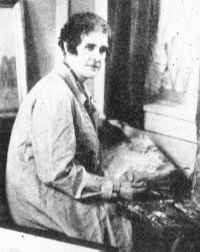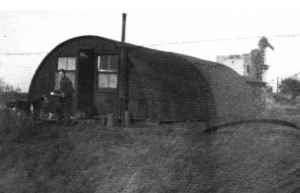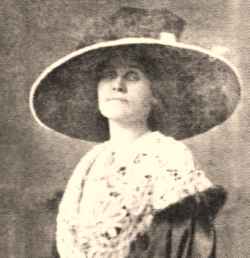Mary Riter Hamilton

The artist at her studio in Winnipeg
- Born in Teeswater, Ontario in 1873 to parents John and Charity Riter (nee Zimmerman).
- Mary moved to Clearwater, Manitoba as a small child. She spent her early years there and married Charles W. Hamilton in 1889.
- The newlyweds moved to Port Arthur where Charles became a "leading merchant" running one of the town’s general stores.
- Mary returned to Manitoba in 1893 following Charles’ death where she opened a china painting school. This was a very popular art form of the period and success soon followed.
- Following a brief period of study in Toronto, she departed for Europe to continue her education in 1901.
- She spent her first year in Berlin studying under Italian landscape artist Franz Skarbina. The following year she moved to Paris to study under several well-known artists including Jacques-Emile Blanche and Paul-Jean Gervais.
- By 1909 her work began to get recognition. Her painting, Les Pauvres, was displayed at The Salon which meant acceptance by the French Academy. This same painting would later be on display in 1915 at the Panama-Pacific Exhibition held in San Francisco.
- She returned to Winnipeg in 1911 due to her mother’s failing health - only her second visit home since her initial trip to the continent in 1901. She brought with her a collection of nearly one hundred and fifty oils and water colors. They went on display at several galleries in 1911 and early 1912 where they were met with favorable reviews.
- Mary would remain in Winnipeg through the war. She decided to try her hand at a Candian landscape series which included scenes of Alberta and native Indians. While the works were met positively, they would not afford her the luxury of financial independence.
- During the war, Mary would donate paintings to aid in fundraising activities.
- In 1919 she was commissioned by H. F. Paton’s Gold Stripe, which was a tribute to those who were killed, maimed and wounded in the Great War, to produce paintings of the French battlefields for reproduction in the publication.
- She spent the years from 1919 until 1922 living in France alone in a tin hut amid the Chinese workers hired to clear the Western Front of the debris of war. The conditions ran the gamut from uncomfortable to downright dangerous due to gangs of "criminals" roaming the region.
- Her paintings were exhibited in both Vancouver and Victoria as well as being published in the Gold Stripe. While they were well received, her biggest successes were in France and
Britain. At the Somme Memorial Exhibit she was awarded the purple ribbon of Les Palmes Academiques, the Order of Public Instruction. She was the only Canadian artist to be recognized in this fashion. Her battlefield art went on to win more awards including the gold medal at the International Decorative Arts Exhibition of 1925.
- She returned to Winnipeg in 1925, blind in one eye due to an illness in 1923, where she once again opened a teaching studio.
- In July of 1925 she donated 227 of her battlefield works to the Canadian Public Archives.
- She moved to Vancouver in 1929 and again opened a teaching studio. By 1948, her health failing and undergoing financial difficulties, she gave up the studio.
- She died in Vancouver in 1954 at the age of 81. She is buried in Port Arthur next to her husband Charles.
She has left us with a clear memories of a terrible war, frozen in time in charcoal, water colors, and oils. They capture an emptiness that is hard to describe in words alone.

Mary outside her hut in France
|



